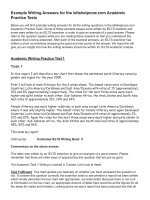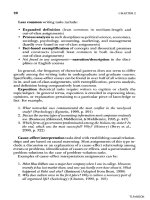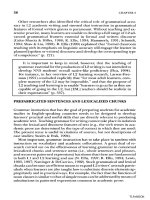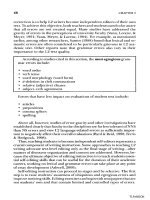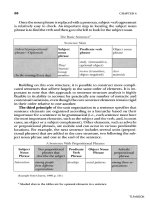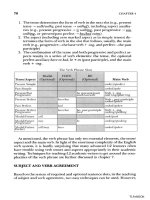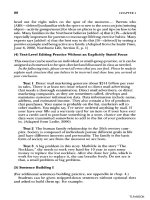Academic writing Academic writing Academic writing Academic writing Academic writing Academic writing Academic writing Academic writing Academic writing Academic writing Academic writing Academic writing
Bạn đang xem bản rút gọn của tài liệu. Xem và tải ngay bản đầy đủ của tài liệu tại đây (242.78 KB, 4 trang )
104 / Academic Writing for Graduate Students
UnitFive
Writing Summaries
330000
25000
0
1955
1960
1965
1970
1975
1980
1985
1990
Year
Fig. 9. Totals of Canadian and Japanese students in U.S. colleges and
universities (at fiveyear intervals)
The highest pass rate occurred in 1985.
The highest pass rate occurred nine years ago.*
TaskFifteen
Write a suitable data commentary for figure 9. Would you like to
speculate about future trends?
Task Sixteen
Write a data commentary from your own field of study based on
data
Of all the writing tasks so far, summary writing may well be the one
you are most familiar with. We make summaries of many different
things, including conversations, lectures, and readings. Our sum
maries may be quite elaborate, or they may only involve one or two
key words, depending on our purpose for writing them. These sum
maries of what others have written or said are our own private
material. Most often we use this material for future reference. At
the university especially, it can form an essential part of preparation for an exam, a class discussion, or a term/research paper. In
these situations, we are free to concentrate on what we think is
important or interesting about the source.
Sometimes, however, writing a summary becomes a task in itself,
such as when your instructor assigns a summary. In this case, you
are given the opportunity to display your understanding of some
material. This type public summary is relatively common in grad
uate student writing and may be a foundation for other writing
tasks.
In the first half of this textbook, you could successfully complete
most of the writing tasks by relying either on information that you
already possessed or on information that we provided. In the second
half, we will pay more attention to writing that involves the use of
sources. Unit Five deals with assignment summary writing. Unit
Six deals with critiques of (or critical reactions to) source material.
Finally, in the last two units, we move on to writing an entire re
search paper.
that you select.
Writing an Assignment Summary
Assignment summaries can be extremely challenging to write. A
good assignment summary has three principal requirements.
*Of course the number of years ago depends on when you are writing! Here we
assume 1994.
1. It should offer a balanced coverage of the original. (There is a
tendency to devote more coverage to the earlier parts of the
source text.)
106 / Academic Writing for Graduate Students
2. It should present the source material in a neutral fashion.
3. It should condense the source material and be presented in the
summary writer's own words. (Summaries that consist of di
rectly copied portions of the original rarely succeed.)
Notice that we have not said anything about the length of a sum
mary, because this will largely be determined by your instructor.
Often, instructors will ask for a onepage summary of an article (or
maybe a twopage summary of a book). They may also ask for a
paragraphlength abstract (see Unit Eight) or even a minisummary
of 1 to 2 sentences (as is typical of annotated bibliographies). Since
the sample texts we provide here are quite short, we expect that the
summaries you write will be half a page to a full page.
To do a good job, you must first thoroughly understand the source
material you are working with. Here are some preliminary steps in
writing a summary.
1. Skim the text, noting in your mind the subheadings. If there
are no subheadings, try to divide the text into sections. Con
sider why you have been assigned the text. Try to determine
what type of text you are dealing with. This can help you iden
tify important information.
2. Read the text, highlighting important information or taking
notes.
3. In your own words, write down the main points of each section.
Try to write a onesentence summary of each section.
4. Write down the key support points for the main topic, but do
not include minor detail.
5. Go through the process again, making changes as appropriate.
Task One
Read this adaptation of "Transformation of the Nile River Basin"
and underline the information you think is significant and should be
included in a summary. Next to each underlined section, briefly
explain why you think the information is important. The first para
graph has been done for you. Then in as few words as possible, write
in the margin what each paragraph is about.
Writing Summaries / 107
Transformation of the Nile River Basin (adaptation)
The Egyptian landscape has
been changing for centuries.
One area which has under
gone dramatic change over the
last 7,000 years is the Nile
River basin. One of the most
notable aspects of this trans
formation is the yearround
irrigation of land for agri
cultural purposes, rather than
a strict reliance on the annual
flood . Conversion to contin
uous irrigation, which began
around 1500 and was limited
only by the level of technology,
led to improved agricultural
productivity. This in turn con
tributed to an increase in the
population of the area .
Reason for Highlighting
This is the topic of the pas
sage.
The effect of the change in ir
rigation patterns is signifi
cant.
Largescale conversion of
agricultural land involving pe
rennial irrigation began in
1800 with the availability of
more modern technology. Wa
ter could be retained, raised,
and distributed to summer
crops with the aid of bar
rages* constructed on the Nile
below Cairo and at sites on
30,000 km of new canals.
Large dams were built on the
Nile at Aswan in 1902, 1912,
and 1933. The final transfor
*A barrage is a bank of earth or stones usually constructed over a river to provide
water for irrigation.
Writing Summaries / 109
108 / Academic Writing for Graduate Students
to continuous irriga
tion was finished with the
completion of the Aswan Dam
in 1960. This fullscale change
brought about a major shift
and expansion in agriculture.
Cash crops such as cotton,
sugar cane, and vegetables
tended and still tend to be
produced at the expense of
subsistence crops.
Because Egyptians have
historically preferred to live
within or near the cultivated
land area, agricultural expan
sion has also had an impact
on the environment and liveli
hood of the Nile population.
As the amount of land avail
able for agriculture increased,
so did the population. Egypt's
population has increased from
2.5 million in the early 1800s
to 9.7 million in the late 1800s,
18.8 million in the 1940s, 37
million in the mid70s, 46 mil
lion in 1984. The population is
projected to be 65 million by
the beginning of the next cen
tury. In 1907, urban dwellers
constituted only approx
imately 17% of Egypt's popula
tion. By 1976, however, they
were 43% of the total. Recent
studies have indicated that
approximately 12% of Egypt's
arable land is lost annually to
human encroachment.
(Steven M. Goodman, Peter Meininger, et
eds. The Birds of
Egypt (1989). Used by permission of Oxford University Press.)
Task Two
The "Nile" passage is fairly easy to summarize because it is factual,
has three clearcut sections, and follows a chronology. Take a look at
some attempts at summarizing some of the details in the third para
graph. Which summary provides the right amount of detail? Ex
plain your choice.
1. In the early 1800s the population of Egypt was 2.5 million. By
the late 1800s it was 9.7 million. In the 40s the population
reached 18.8 million; by the mid70s it had reached 37 million.
In 1984 the population was 46 million. In the year 2000 it is
estimated that there will be 65 million Egyptians. One to two
percent of Egypt's fertile land is disappearing annually as a re
sult of the growth.
2. In the 1800s Egypt's population increased from 2.5 million to
9.7 million. In the 1900s it grew again, from 18.8 million in the
1940s to 46 million in 1984. By the next century, population
will be 1.5 times that in 1984. A result of this population
growth is an annual 12% loss of agricultural land.
3. The Egyptian population has increased from 2.5 million in the
early 1800s to 46 million in 1984. It is expected to reach 65
million by the year 2000. Along with this population growth,
Egypt has also experienced a yearly 12% loss in the amount
of fertile land.
4. The Egyptian population has dramatically increased since the
1800s and is expected to continue to increase. A small percent
age of agricultural land is lost each year because of the growth
in population.
5. The Egyptian population in 1984 was nearly 20 times that in
the early 1800s. By the next century, it should reach 65 mil
lion. Egypt is also losing agricultural land as a result of the
population increase.
Now attempt your own summary of the third paragraph.
Thank you for evaluating Wondershare PDF Converter.
You can only convert 3 pages with the trial version.
To get all the pages converted, you need to purchase the software from:
/>


